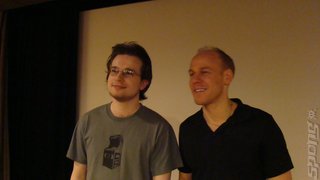Interviews// Just Cause 2: The Interview Part 2
...something that happens dynamically and isn't linear at all
SPOnG recently took a trip out to see Eidos. As well as getting to sink our teeth into Batman: Arkham Asylum, we sat down to talk with Peter Johansson, lead designer over at Avalanche, about the upcoming Just Cause 2.
You can see the first part of that interview here and the second... well, that's right below these very words.
SPOnG: So a lot of environmental things such as weather conditions, have been improved? I found that quite impressive in the demo, where travelling from a forest to a snowy mountain had a pretty seamless change in climate.
Peter Johansson: Yeah, and that's a really nice feeling, isn't it? To be able to seamlessly go through one environment to another, and we have all sorts of graphical transitions like this. Then on top of that we have this dynamic weather system, which is completely independent of this. If you get to an area where clouds start to form, it'll start getting darker and then you'll get a thunderstorm. It's really nice, and something that happens dynamically and isn't linear at all.
SPOnG: How did you approach the game's design so that, in this huge expansive world where you can do anything, it still felt natural to progress onto missions at your own pace? Was there a point at all where you wanted to guide the player when it's necessary?
Peter Johansson: That's definitely a challenge, and an important balance to get right because 'freedom' is a nice buzzword and makes the player think 'Great, I can do whatever I like', but at the same time too much freedom can become pretty boring and not fun at all. If you don't get that balance right to guide the player on when they want to progress, they'll get confused with the gameplay.
Basically, we have all these tools in the game like the parachute and grappling hook that you can use to play around, but they're also used to help a player negotiate his way around the map easily. We have a lot of these goals and identifiers to lead you to those particular missions, to take some of the confusion out.
We have strongholds in the game, which you take over using different factions to unlock more of the map to explore, and then you get to increase your influence over the area that you control by causing chaos. As you do this, more missions become unlocked when your influence reaches a certain radius, and that's how the structure of the game works.
So you're not bombarded with loads of missions and an entire country when you start playing the game, there's a sense of progression to it that allows you to spend as much time as possible in the area you have before you feel like taking control of more areas. Intertwining the freedom of chaos, mission progression and map unlocking together allows the player to do either at their own pace without impacting the other elements.
You can see the first part of that interview here and the second... well, that's right below these very words.
SPOnG: So a lot of environmental things such as weather conditions, have been improved? I found that quite impressive in the demo, where travelling from a forest to a snowy mountain had a pretty seamless change in climate.
Peter Johansson: Yeah, and that's a really nice feeling, isn't it? To be able to seamlessly go through one environment to another, and we have all sorts of graphical transitions like this. Then on top of that we have this dynamic weather system, which is completely independent of this. If you get to an area where clouds start to form, it'll start getting darker and then you'll get a thunderstorm. It's really nice, and something that happens dynamically and isn't linear at all.
SPOnG: How did you approach the game's design so that, in this huge expansive world where you can do anything, it still felt natural to progress onto missions at your own pace? Was there a point at all where you wanted to guide the player when it's necessary?
Peter Johansson: That's definitely a challenge, and an important balance to get right because 'freedom' is a nice buzzword and makes the player think 'Great, I can do whatever I like', but at the same time too much freedom can become pretty boring and not fun at all. If you don't get that balance right to guide the player on when they want to progress, they'll get confused with the gameplay.
Basically, we have all these tools in the game like the parachute and grappling hook that you can use to play around, but they're also used to help a player negotiate his way around the map easily. We have a lot of these goals and identifiers to lead you to those particular missions, to take some of the confusion out.
We have strongholds in the game, which you take over using different factions to unlock more of the map to explore, and then you get to increase your influence over the area that you control by causing chaos. As you do this, more missions become unlocked when your influence reaches a certain radius, and that's how the structure of the game works.
So you're not bombarded with loads of missions and an entire country when you start playing the game, there's a sense of progression to it that allows you to spend as much time as possible in the area you have before you feel like taking control of more areas. Intertwining the freedom of chaos, mission progression and map unlocking together allows the player to do either at their own pace without impacting the other elements.



